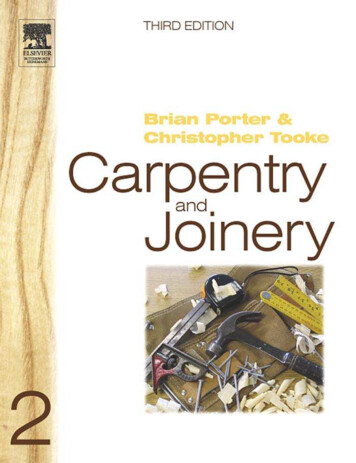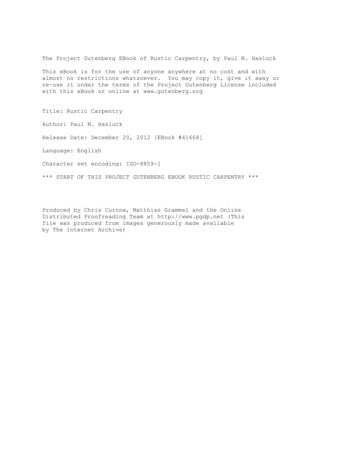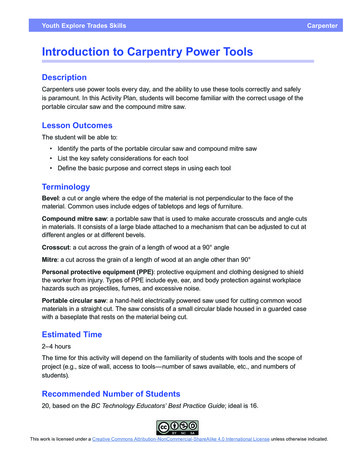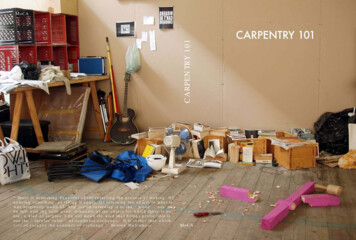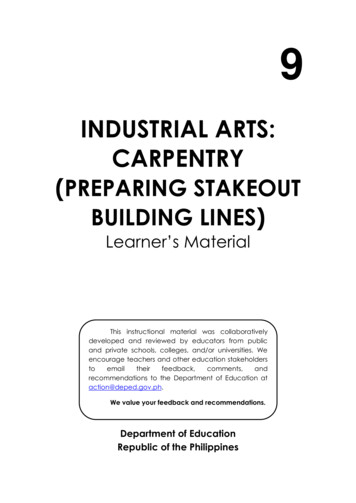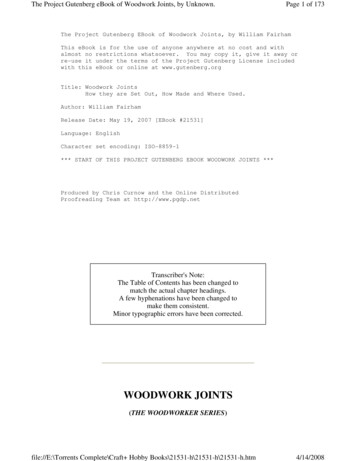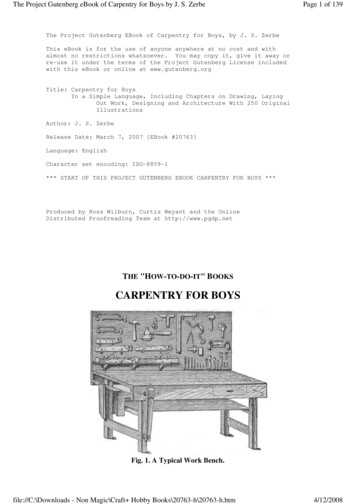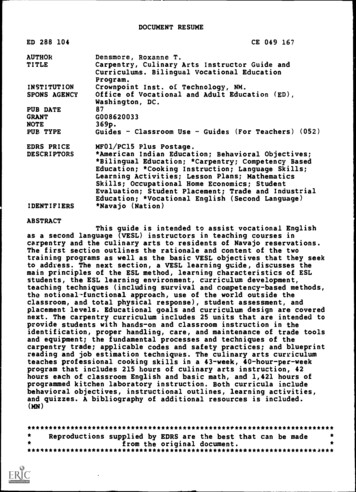
Transcription
Carpentry TechnologyIntroduction to Carpentry (CAR701A)Course DescriptionIntroduction to Carpentry Technology allows the student to explore the trade of carpentry. Studentswill be introduced to the tools, equipment, and practices common to the trade, with a constant emphasison safe work habits. Students will develop their knowledge of solid wood products and be able to describetheir characteristics and applications in industry. They will identify, explore, and apply various methodsof wood joinery while developing technical skills with various hand and power tools common to thecarpentry trade. They will also develop skills in communication through drafting, and apply basic mathconcepts to solve trade-related problems. This is a recommended prerequisite course for all othercarpentry technology courses.Classroom Component—Suggested time: 22 hoursThis component of the curriculum is required to teach the knowledge and skills associated with thelearning outcomes of the curriculum.Skill Development Component—Suggested time: 88 hoursThis component of the curriculum is required by the student to apply the knowledge and develop theskills related to the learning outcomes of the curriculum.SCO - Identifies the Specific Curriculum Outcome (SCO)Column 1SCO - DelineationsDescribes what the students are expected toknow, be able to do, and value in order toachieve the SCO.The teacher is responsible for the planningand facilitation of learning as well as theassessment of each SCO - Delineation.Column 3Teacher Lessons / DemonstrationsProvides suggestions for developing anddelivering the content for student learning.Student Activities / AssessmentsProvides suggestions for creatingmeaningful activities to allow the studentto achieve the SCO.Column 2Student Knowledge, Abilities, and CompetenciesProvides clarity to the SCO by describing the Knowledge,Abilities, and Competencies that the students develop. Thiscolumn is designed to indicate the depth and breadth of the SCO.It is not necessary to use all of these suggestions or that all of thestudents be engaged in the same learning activity.Column 4ResourcesLists a variety of resources that support the teaching and learningrelated to the SCO. These resources are suggested to support theteacher in developing an effective instructional package for deliveryto the students.1
CURRICULUM OUTCOMESModule 1: Work Site Safety ( 3 hours Classroom Component)1.Students will be able to apply Occupational Health and Safety Regulations and safe work practicesin the workplace.Students will be expected to1.1interpret occupational health and safety regulations1.2describe requirements related to personal protective equipment and safety measures1.3describe emergency procedures for dealing with injured workers1.4describe potential health hazardsModule 2: Solid Wood Products ( 3 hours Classroom Component)2.Students will be able to identify and describe solid wood products and joinery.Students will be expected to2.1describe common types and characteristics of solid wood products2.2describe how wood is milled, seasoned, stored, and ordered2.3identify and describe the application of commonly used mouldings2.4identify and describe the application of wood joints for fabrication and installationModule 3: Hand Tools ( 32 of 88 hours Skill Development Component, 4 hours Classroom Component)3.Students will be able to identify common hand tools and describe their proper uses.Students will be expected to3.1identify and describe the use of measuring, marking, layout, alignment, and squaring tools3.2identify and describe the use of cutting tools, boring tools, and drilling tools3.3identify and describe the use of assembling, clamping, and dismantling tools3.4demonstrate the use of hand tools to construct projects using wood materialsModule 4: Portable Power Tools ( 16 of 88 hours Skill Development Component, 2 hours ClassroomComponent)4.Students will be able to identify and describe the safe operation and maintenance of portablepower tools.Students will be expected to4.1identify and describe the safe operation of portable saws4.2identify and describe the safe operation of portable planing and shaping equipment4.3identify and describe the safe operation of portable drilling and fastening equipment4.4identify and describe the safe operation of portable abrasive tools4.5demonstrate tool proficiency through selected shop projects using a variety of building materials2CAREER AND TECHNICAL EDUCATION CURRICULUM
CURRICULUM OUTCOMESModule 5: Stationary Power Tools ( 16 of 88 hours Skill Development Component, 2 hours ClassroomComponent)5.Students will be able to identify and describe the safe operation and maintenance of stationarypower tools and demonstrate tool proficiency through selected shop projects.Students will be expected to5.1identify and describe the safe operation and regular maintenance of stationary saws5.2identify and describe the safe operation and regular maintenance of stationary planing tools5.3identify and describe the safe operation and regular maintenance of stationary drilling, grinding, andsanding toolsModule 6: Drafting Basics ( 4 hours Classroom Component)6.Students will be able to identify and demonstrate the use of basic drawing instruments.Students will be expected to6.1describe the function of basic drawing equipment6.2use drafting equipment to complete geometric exercises6.3describe the applications of geometry in trade situations6.4practise producing shapes and angles and drawing to scale with basic drafting instrumentsModule 7: Basic Math Concepts ( 4 hours Classroom Component)7.Students will be able to use a calculator and apply basic math concepts to solve trade-relatedproblems using both metric and imperial systems of measurement.Students will be expected to7.1describe basic math concepts and operations7.2describe the basic calculator functions and operations7.3describe the metric measurement system (SI)7.4describe the imperial measurement system7.5describe calculations involving fractions7.6convert measurements between metric and imperial systems7.7work with equations7.8describe calculations using the Pythagorean theoremCAREER AND TECHNICAL EDUCATION CURRICULUM3
4CAREER AND TECHNICAL EDUCATION CURRICULUM
CAR701A - INTRODUCTION TO CARPENTRYWork Site Safety( 3 hours Classroom Component)IntroductionThe Occupational Health and Safety Act provides employers and employees withinformation on how to create and work in a safe working environment. The OHS Actcannot prevent injuries. It is the responsibility of the apprentice to understand his/herrole as related to safety, and the role and responsibility of the employer.SpecificCurriculumOutcome1.Students will be able to apply Occupational Health and Safety Regulationsand safe work practices in the workplace.SCO - Delineations Students will be expected to1.11.21.31.4interpret occupational health and safety regulationsdescribe requirements related to personal protective equipment and safety measuresdescribe emergency procedures for dealing with injured workersdescribe potential health ssessmentsSkills PerformanceTeacher ObservationCareer PortfolioResourcesAlberta Module 020101a, Work Site SafetyCAREER AND TECHNICAL EDUCATION CURRICULUM5
CAR701A - INTRODUCTION TO CARPENTRY - MODULE 1Work Site Safety ( 3 hours Classroom Component)SCO 1. Students will be able to apply Occupational Health and Safety Regulations and safe work practices inthe workplace.SCO - DelineationsStudents will be expected toStudent Knowledge, Abilities, and Competencies1.1interpret occupationalhealth and safety regulationsTopic: Occupational Heath and Safety Describe responsibilities of the employer regarding work site safety. Describe responsibilities of the employee regarding work site safety. Demonstrate a positive attitude towards safety. Explain general safety precautions related to- work site planning- joint work site health and safety committee- housekeeping- tool safety- electrical safety- accident prevention, and reporting of unsafe conditions. Describe safety training required by employers: (e.g., first aid,WHMIS). Demonstrate an understanding of the Occupational Health andSafety Act of PEI.1.2describe requirements relatedto personal protectiveequipment and safetymeasuresTopic: Personal Protective Equipment (PPE) Identify and describe the use of common personal protectiveequipment (PPE) required in the carpentry trade:- head protection- eye protection- ear protection- foot protection- limb and body protection- respiratory protection Demonstrate the use of PPE in the workshop.Topic: Safety Measures Describe responsibilities related to working alone (employee/employer). Explain the hazards related to working with compressed air. Explain the purpose and function of equipment guards. Describe “lock-out/tag-out” procedures while maintainingequipment. Describe safety practices related to working with or around trenches. Describe the proper method of installing and removing shoring,stringers, and bracing of a trench. Describe the difference between a trench and an excavation. Define “spoil pile.” Describe the proper method for guarding and identifying flooropenings. Describe factors to consider when planning a fall arrest system. Compare and contrast a body belt and a body harness. Describe the risks in working with asbestos, along withrecommended safety precautions.6CAREER AND TECHNICAL EDUCATION CURRICULUM
CAR701A - INTRODUCTION TO CARPENTRY - MODULE 1Work Site Safety ( 3 hours Classroom Component)SCO 1. Students will be able to apply Occupational Health and Safety Regulations and safe work practices inthe workplace.Teacher Lessons / DemonstrationsTopic: Occupational Health and Safety Discussion Introduce the topic of safety—not as a lesson, but as a way ofworking and living every day, developing safe habits and thinking“safety first.” Point out any P.E.I. rules and regulations which may differ from thosein the ILM. Introduce the Occupational Health and Safety Act of P.EI. Indicate the importance of basic first aid certification.LiteracyAnticipation Guide: Create an anticipation guide to assess students’ priorknowledge of personal protective equipment, (PPE).Document Reading: Read relevant sections of the P.E.I. Occupational Health and Safety Act the Guide to Workplace Safety for Residential Construction Sites.Topic: Personal Protective Equipment (PPE) Identify the location of and understand expectations for the use of PPE. Model and demonstrate the care of PPE. Model and demonstrate specific lab requirements for PPE.Topic: Safety Measures Guide students through a “walkabout” around the lab, highlightingall of the safety features (e.g., location of fire extinguishers, fire exits,first-aid kits, PPE). Discuss fire safety and evacuation routes. As a follow-up the next day.- before the class arrives, take the time to stage 10 work site safetyproblems (e.g., remove the fire exit signs or switch the fireextinguishers). Brainstorm in a class discussion the lab safety rules and safety contract. Show safety videos. Identify and demonstrate the various machine safety features andguards. Model and demonstrate lock-out/tag-out procedures. Use a KWL chart as a prompt for students to discuss aspects of fallprotection.ResourcesTexts/Teacher ResourcesAlberta Module 020101aWork Site Safetypp. 1-36Occupational Health and Safety ActSAS Resource SharingVideos Lost Youth It Only Takes a Second Things You’d Better Know.Visuals/Handouts/Tests Lab safety rules Safety contract Rights and Responsibilities OHS exercise Guide to Workplace Safety forResidential Construction SitesInternetWorkSafeLiteracy Freewrite: Have students write about their current knowledge andprevious use of personal protective equipment.Student Activities / Assessments Review lab safety rules and sign safety contract. Identify PPE equipment. Prepare a safety plan to be used in case of an accident. Write a test on safe work practices in the workplace. Draw a detailed floor plan of the lab on grid paper and locate all ofthe safety areas and exits as defined during the walkabout. As a follow-up the next day.- circulate through the lab to identify the work site safetyproblems staged by the instructor.CAREER AND TECHNICAL EDUCATION CURRICULUM7
CAR701A - INTRODUCTION TO CARPENTRY - MODULE 1Work Site Safety ( 3 hours Classroom Component)SCO 1. Students will be able to apply Occupational Health and Safety Regulations and safe work practices inthe workplace.SCO - DelineationsStudents will be expected to1.3describe emergencyprocedures for dealing withinjured workers1.4describe potential healthhazardsStudent Knowledge, Abilities, and CompetenciesTopic: Lab Safety Locate and identify all emergency-related features in the labenvironment:- eye wash stations- emergency exits- first-aid kit- certified first aider- fire extinguisher- fire alarm- telephone- emergency phone numbers Describe how to properly handle an emergency situation shouldone arise.1. Take charge.2. Call out for help.3. Assess hazards and make the area safe.4. Find out what happened.5. Identify yourself and offer help.6. If head or spinal injuries are suspected, support the head orneck.7. Assess responsiveness.8. Send someone or go for help.9. Administer first aid.Topic: Impact Loading Define “static loading”, and “impact loading.” Explain the importance of not impact loading a scaffold.Topic: Personal Safety Identify the characteristics of and preventative measures for thefollowing:- heatstroke- frostbite- hypothermia- fatigue Identify the hazards and preventative measures for exposure to thefollowing:- natural wood dust- lead-based paint- carbon monoxide- flammable liquids and gases Interpret MSDS and product label information. Demonstrate how to properly lift and handle heavy objects.8CAREER AND TECHNICAL EDUCATION CURRICULUM
CAR701A - IN
Carpentry Technology Introduction to Carpentry (CAR701A) Course Description Introduction to Carpentry Technology allows the student to explore the trade of carpentry. Students will be introduced to the tools, equipment, and practices common to the trade, with a constant emphasis on safe work habits. Students will develop their knowledge of solid wood products and be able to describe their .File Size: 273KBPage Count: 54
